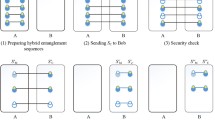Abstract
It shows that there are some serious security issues in the controlled quantum secure direct communication (CQSDC) with authentication protocol based on four particle cluster states via quantum one-time pad and local unitary operations. Some information of the identity strings of the receiver and the controller can be stolen without being detected by the intercept-selectively-measure-resend (ISMR) attack. Furthermore, an eavesdropper (Eve) can eavesdrop on some information of the secret message that the sender transmits. In addition, the receiver can obtain half of information about the secret message without any active attack and the permission of the controller, which is not allowed in a secure CQSDC protocol. The receiver can take the ISMR attack to obtain more information about the secret message without the permission of the controller. If running the protocol many times, the identity strings of the receiver and the controller can be completely acquired by Eve. Finally, the original CQSDC protocol is improved to a secure one.

Similar content being viewed by others
References
Deng, F.G., Long, G.L., Liu, X.S.: Two-step quantum direct communication protocol using the einstein-podolsky-rosen pair block. Phys. Rev. A 68, 042317 (2003)
Deng, F.G., Long, G.L.: Secure direct communication with a quantum one-time pad. Phys. Rev. A 69, 052319 (2004)
Wang, C., Deng, F.G., Li, Y.S., Liu, X.S., Long, G.L.: Quantum secure direct communication with high-dimension quantum superdense coding. Phys. Rev. A 71, 044305 (2005)
Long, G.L., Deng, F.G., Wang, C., Li, X.H.: Quantum secure direct communication and deterministic secure quantum communication. Front. Phys. China 2, 251–272 (2007)
Liu, Z.H., Chen, H.W., Liu, W.J., Xu, J., Li, Z.Q.: Deterministic secure quantum communication without unitary operation based on high-dimensional entanglement swapping. Sci. China-inf. Sci. 55, 360–367 (2012)
Liu, Z.H., Wu, C., Liu, W.J., Xu, J., Wang, D., Li, Z.Q.: Quantum secure direct communication with optimal quantum superdense coding by using general four-qubit states. Quantum Inf. Process. 12, 587–599 (2013)
Liu, Z.H., Chen, H.W., Wang, D., Xue, X.L.: Classical-operation-based deterministic secure quantum communication. Int. J. Theor. Phys. 53, 2118–2129 (2014)
Li, X.H.: Quantum secure direct communication. Acta Phys. Sin. 64, 0160307 (2015)
Wang, J., Zhang, Q., Tang, C.J.: Multiparty controlled quantum secure direct communication using greenberger-horne-zeilinger state. Opt. Commun. 266, 732–737 (2006)
Hassanpour, S., Houshmand, M.: Efficient controlled quantum secure direct communication based on GHZ-like states. Quantum Inf. Process. 14, 739–753 (2015)
Tan, X.Q., Zhang, X.Q.: Controlled quantum secure direct communication by entanglement distillation or generalized measurement. Quantum Inf. Process. 15, 2137–2154 (2016)
Nanvakenari, M., Houshmand, M.: An efficient controlled quantum secure direct communication and authentication by using four particle cluster states. Int. J. Quantum. Inf. 14, 1750002 (2017)
Zhong, J., Liu, Z., Xu, J.: Analysis and improvement of an efficient controlled quantum secure direct communication and authentication protocol. CMC 57, 621–633 (2018)
Liu, Z.-H., Chen, H.-W.: Cryptanalysis and improvement of quantum broadcast communication and authentication protocol with a quantum one-time pad. Chin. Phys. B 25, 080308 (2016)
Liu, Z., Chen, H., Liu, W.: Cryptanalysis of controlled quantum secure direct communication and authentication protocol based on five-particle cluster state and quantum one-time pad. Int. J. Theor. Phys. 55, 4564–4576 (2016)
Acknowledgements
This work was supported by National Natural Science Foundation of China (Grant Nos. 61502101 and 61871120), and Natural Science Foundation of Jiangsu Province, China (Grant No. BK20171458) and the Six Talent Peaks Project of Jiangsu Province (Grant No. XYDXX-003).
Author information
Authors and Affiliations
Corresponding authors
Additional information
Publisher’s Note
Springer Nature remains neutral with regard to jurisdictional claims in published maps and institutional affiliations.
Rights and permissions
About this article
Cite this article
Liu, Z., Chen, H. Cryptanalysis of the Efficient Controlled Quantum Secure Direct Communication and Authentication by Using Four Particle Cluster States Protocol. Int J Theor Phys 58, 1989–1998 (2019). https://doi.org/10.1007/s10773-019-04092-w
Received:
Accepted:
Published:
Issue Date:
DOI: https://doi.org/10.1007/s10773-019-04092-w




